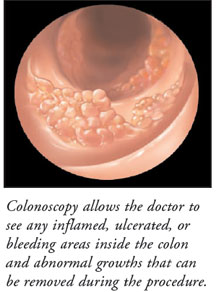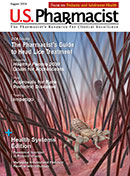
Effective Screening for Colon Cancer
Colonoscopy is an outpatient procedure used to diagnose diseases of the colon, or large intestine. It is often used to investigate a symptom of colon disease, such as bleeding in the stool, abdominal pain, or a change in bowel movements. It is also used to screen for colon cancer, especially in patients who have a risk for colon cancer but do not have symptoms. During a colonoscopy, the gastroenterologist looks inside the colon with a thin, flexible tube that has a tiny camera and light at one end. The tube is inserted into the rectum and slowly guided through the colon, allowing the inside of the colon to be seen on a TV monitor. Small growths on the lining of the colon, known as polyps, can be removed using a special instrument that is passed through the tube. Before the colonoscopy, the patient must carefully follow the doctor’s instructions to completely empty the colon. During the procedure, an IV line is started and medication is administered to make the patient relaxed and drowsy (conscious sedation) or asleep (light general anesthesia). The colonoscopy usually lasts about 30 minutes. After the medication effects have worn off, the patient is allowed to be driven home.
What a Colonoscopy Reveals
A colonoscopy is a procedure often used to diagnose the cause of symptoms such as blood in the stool or to look for signs of colon cancer before symptoms appear. A colonoscopy can reveal more information than tests such as an x-ray or barium enema because it allows the doctor to see inflammation, ulcerations, bleeding, or abnormal growths (polyps) in the colon.
Before the Procedure:
In order to have an accurate exam, the patient must completely clean out the colon by carefully following dietary and medication instructions. Before the colonoscopy, the doctor should be informed of all prescription and over-thecounter medications the patient is taking, since there are certain medications that may interfere with the test. Most patients are instructed to begin a clear liquid diet, including broth, tea, soda, gelatin (any color but red), and other similar liquids for a day or two before the procedure. The patient may also be asked to use a laxative or enema to make sure the colon is clear before the exam. Following these instructions is very important to ensure a successful exam and avoid the necessity of repeat exams.
During the Procedure:
The patient is usually placed on a heart monitor, and an IV line is started. Medication is given through this IV line to ensure the patient is comfortable and relaxed, but in most cases still awake. The patient lies on the left side or back as the colonoscope tube is slowly passed through the colon. Small amounts of air are blown into the colon as the tube moves forward, which can sometimes cause bloating or cramping. Once the tube reaches the end of the colon, it is slowly withdrawn and the lining of the colon is examined again. If necessary, a sample of colon tissue (tissue biopsy) can be taken through an instrument threaded through the colonoscope for later examination in the laboratory. Polyps, or tiny growths that can become cancerous, are also removed using this instrument. Although these growths are often benign, they are examined in the laboratory to rule out cancer.
After the Procedure:
The patient is observed in a recovery area until the effects of the medications used for relaxation have worn off. Cramping or pressure in the abdomen is relieved by passing gas. The doctor will explain the immediate findings of the exam, although the laboratory results may take several days to be interpreted. The patient is not allowed to drive home, even if feeling alert, due to slowed reflexes. Someone must be available to take the patient home. Most patients can eat normally after they return home from the procedure, although the doctor may instruct them on diet and activity if they have had a tissue biopsy performed or polyps removed.
A Safe Process:
Colonoscopy performed by a gastroenterologist is a safe procedure and complications are rare (less than 1%). The most common complication is mild bleeding from the area if a biopsy has been performed or a polyp removed. In the case of heavy bleeding (hemorrhage), a blood transfusion or surgical repair could be needed. It is possible to have a reaction to the medications used for pain and relaxation. Sometimes a vein becomes irritated, red, or swollen from the IV line. Very rarely, a tear (perforation) could occur in the wall of the colon, requiring surgical repair. If the patient notices any unusual symptoms, such as abdominal pain, fever, or heavy rectal bleeding after a colonoscopy, the gastroenterologist should be notified right away.
Your pharmacist can answer any questions you may have about medications used to cleanse the bowel in preparation for a colonoscopy.






